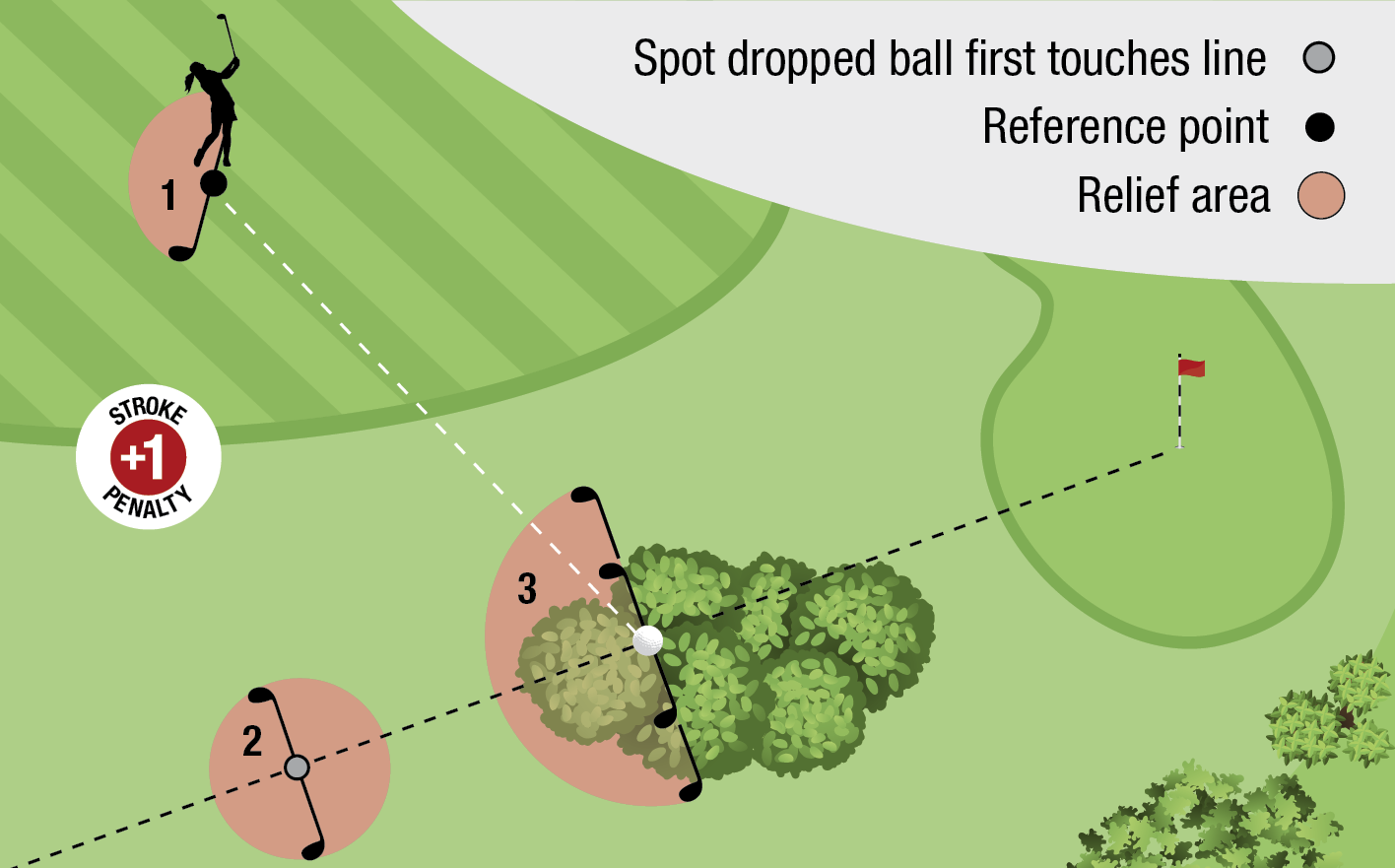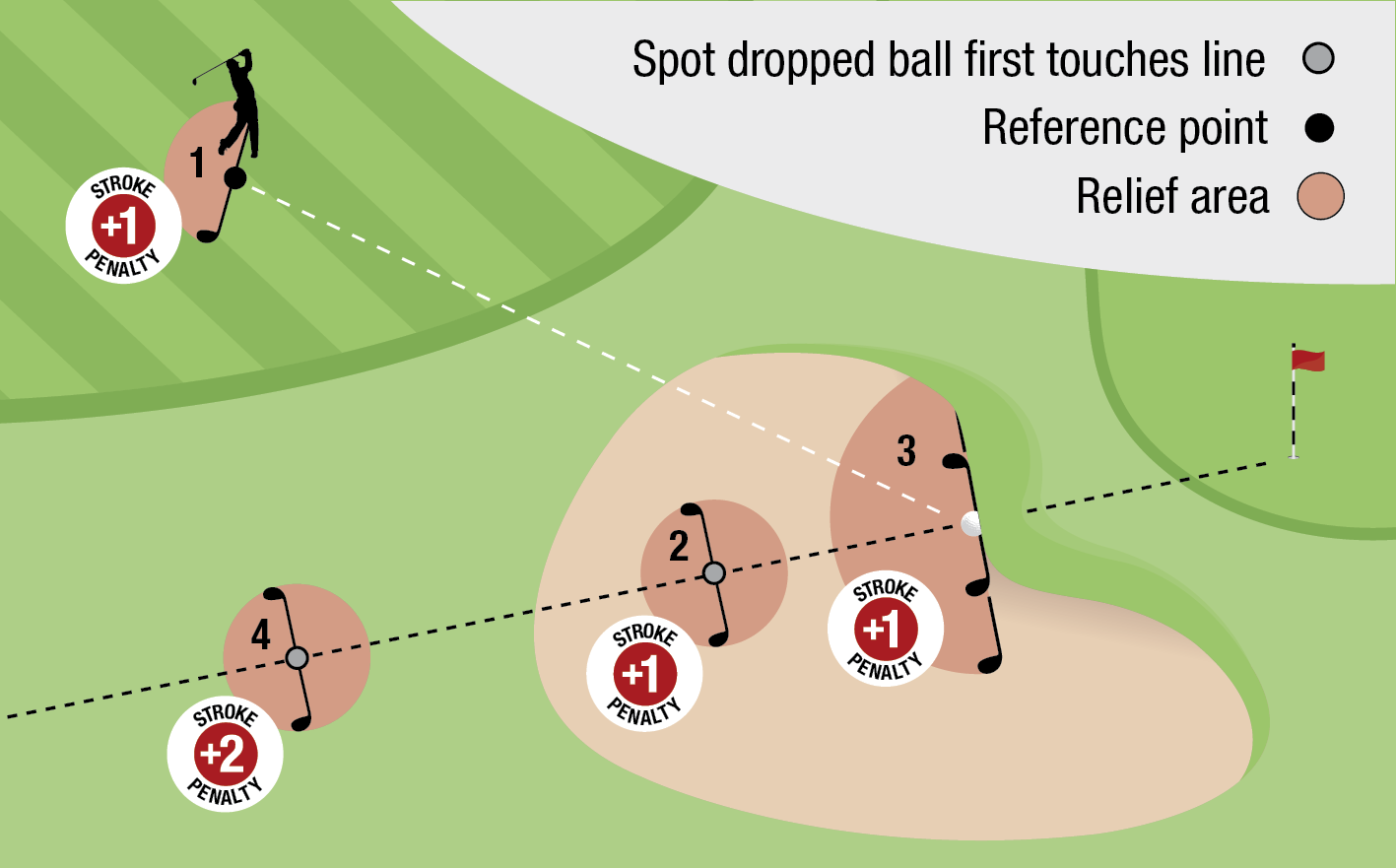Jump to section
Print Section
19Unplayable Ball
19
Unplayable Ball
Purpose of Rule: Rule 19 covers the player’s several relief options for an unplayable ball. This allows the player to choose which option to use – normally with one penalty stroke – to get out of a difficult situation anywhere on the course (except in a penalty area).
19
Unplayable Ball
19.1
Player May Decide to Take Unplayable Ball Relief Anywhere Except Penalty Area
A player is the only person who may decide to treat their ball as unplayable by taking penalty relief under Rule 19.2 or 19.3.
Unplayable ball relief is allowed anywhere on the course, except in a penalty area.
If a ball is unplayable in a penalty area, the player’s only relief option is to take penalty relief under Rule 17.
19.2
Relief Options for Unplayable Ball in General Area or on Putting Green
A player may take unplayable ball relief using one of the three options in Rule 19.2a, b or c, in each case adding one penalty stroke.
- The player may take stroke-and-distance relief under Rule 19.2a even if the original ball has not been found and identified.
- But to take back-on-the-line relief under Rule 19.2b or lateral relief under Rule 19.2c, the player must know the spot of the original ball.
19.2a
Stroke-and-Distance Relief
The player may play the original ball or another ball from where the previous stroke was made (see Rule 14.6).
19.2b
Back-on-the-Line Relief
The player may drop the original ball or another ball (see Rule 14.3) behind the spot of the original ball, keeping the spot of the original ball between the hole and the spot where the ball is dropped (with no limit as to how far back the ball may be dropped). The spot on the line where the ball first touches the ground when dropped creates a relief area that is one club-length in any direction from that point, but with these limits:
- Limits on Location of Relief Area:
- Must not be nearer the hole than the spot of the original ball, and
- May be in any area of the course, but
- Must be in the same area of the course that the ball first touched when dropped.
19.2c
Lateral Relief
The player may drop the original ball or another ball in this lateral relief area (see Rule 14.3):

- Reference Point: The spot of the original ball. But when the ball lies above the ground, such as in a tree, the reference point is the spot directly below the ball on the ground.
- Size of Relief Area Measured from Reference Point: Two club-lengths, but with these limits:
- Limits on Location of Relief Area:
- Must not be nearer the hole than the reference point, and
- May be in any area of the course, but
- If more than one area of the course is located within two club-lengths of the reference point, the ball must come to rest in the relief area in the same area of the course that the ball first touched when dropped in the relief area.
DIAGRAM 19.2: RELIEF OPTIONS FOR UNPLAYABLE BALL IN GENERAL AREA

A player decides that their ball in a bush is unplayable. The player has three options, in each case adding one penalty stroke. The player may:
- Take stroke-and-distance relief by playing a ball from a relief area based on where the previous stroke was made.
- Take back-on-the-line relief by dropping a ball behind the spot of the original ball, keeping the spot of the original ball between the hole and the spot on which the ball is dropped.
- Take lateral relief. The reference point for taking relief is the spot of the original ball and a ball must be dropped in and played from the two club-length relief area, which is no nearer the hole than the reference point.
19.3
Relief Options for Unplayable Ball in Bunker
19.3a
Normal Relief Options (One Penalty Stroke)
When a player’s ball is in a bunker:

- The player may take unplayable ball relief for one penalty stroke under any of the options in Rule 19.2, except that:
- The ball must be dropped in and come to rest in the bunker if the player takes either back-on-the-line relief (see Rule 19.2b) or lateral relief (see Rule 19.2c).
DIAGRAM 19.3: RELIEF OPTIONS FOR UNPLAYABLE BALL IN BUNKER

A player decides that their ball in a bunker is unplayable. The player has four options:
- For one penalty stroke, the player may take stroke-and-distance relief.
- For one penalty stroke, the player may take back-on-the-line relief in the bunker.
- For one penalty stroke, the player may take lateral relief in the bunker.
- For a total of two penalty strokes, the player may take back-on-the-line relief outside the bunker.
19.3b
Extra Relief Option (Two Penalty Strokes)
As an extra relief option when a player’s ball is in a bunker, for a total of two penalty strokes, the player may take back-on-the-line relief outside the bunker under Rule 19.2b.
See Rule 25.4n (for players who use a wheeled mobility device, the back-on-the-line extra relief option in Rule 19.3b is reduced to one penalty stroke).
Penalty for Playing Ball from a Wrong Place in Breach of Rule 19.3: General Penalty under Rule 14.7a.